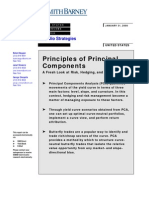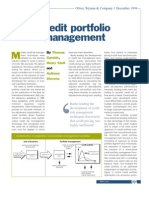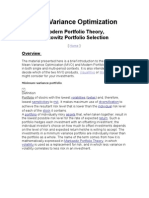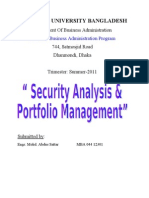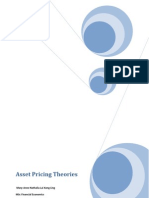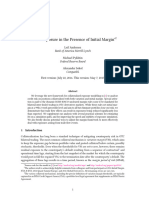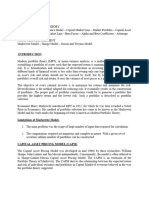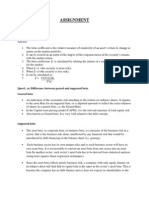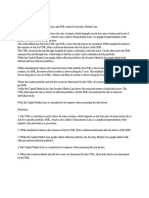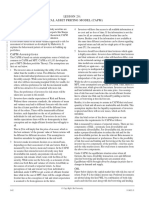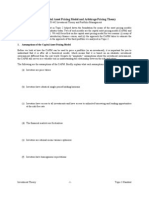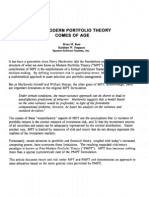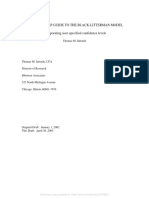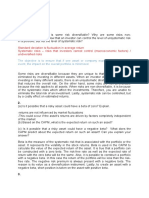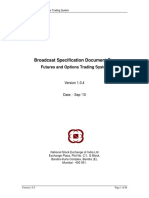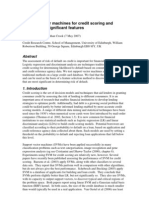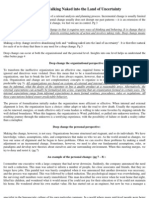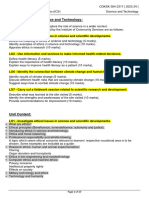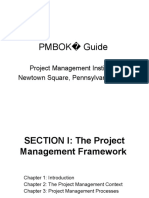Zephyr Concepts - Black-Litterman
Zephyr Concepts - Black-Litterman
Uploaded by
Gautam PraveenCopyright:
Available Formats
Zephyr Concepts - Black-Litterman
Zephyr Concepts - Black-Litterman
Uploaded by
Gautam PraveenCopyright
Available Formats
Share this document
Did you find this document useful?
Is this content inappropriate?
Copyright:
Available Formats
Zephyr Concepts - Black-Litterman
Zephyr Concepts - Black-Litterman
Uploaded by
Gautam PraveenCopyright:
Available Formats
21
January/February 2009
F E AT URE
The Black-Litterman Model
An Introduction for the Practitioner
By Thomas Becker, PhD
B
y far the most common asset
allocation technique for stock
and bond portfolios is the mean-
variance optimization (MVO) method
as set forth by the pioneering work of
Harry Markowitz in the 1950s. Te
enormous popularity of this time-
honored method notwithstanding, prac-
titioners long have had serious com-
plaints regarding the results of MVO.
Te two main issues are:
Portfolios created with MVO tend
to be unintuitive insofar as they are
poorly diversied; that is, they are
highly concentrated in just a few or
even in just one asset class.
Te portfolios that MVO creates
are highly sensitive to the return
forecasts that form part of the input
to the MVO algorithm. In other
words, a minor change in the return
forecasts for the asset classes often
will result in radically dierent allo-
cations to the asset classes.
Te Black-Litterman model (BLM)
provides a front end to the MVO
method that addresses both issues.
More precisely, the BLM is a method
to create stable and consistent return
forecasts for a set of asset classes. When
these return forecasts are used as input
to the MVO algorithm, the resulting
portfolios tend to be well-diversied
and stable, thus resolving the two prob-
lems stated above.
Because the BLM is so closely
related to MVO, I will begin with a
brief recapitulation of the basics of
MVO. After that, I will explain how the
BLM really is a two-part procedure,
with each part addressing one of the
above complaints.
A Brief Overview of
Mean-Variance Optimization
Suppose we have selected a set of asset
classesrepresented, for example, by
a set of mutual fundsfrom which we
wish to build a portfolio. In the most
general terms, optimizing the portfolio
means to achieve the best return with
the least amount of risk. To do that,
we will of course need some sort of
forecast for the behavior of the indi-
vidual asset classes. MVO requires us to
provide estimates of the following:
the expected value of the period
return of each asset class
the standard deviation of each
asset class
the correlation coe cient between
each pair of asset classes
Based on these estimates, the MVO
algorithm calculates, for any desired level
of risk, the portfolio that has the best
expected return with that level of risk.
Here, the measure of risk is the standard
deviation of the portfolio. Te output
is best viewed in a chart as shown in
gure 1, where the horizontal axis shows
standard deviation and the vertical axis
shows expected return. For each value of
the standard deviation, the line plot indi-
cates the best expected return that can
be achieved with a portfolio made up of
the chosen asset classes. Te resulting
curve is called the e cient frontier. In
an interactive chart such as the one pro-
vided by Zephyrs AllocationADVISOR
program, one also can show the portfolio
weights of the optimal portfolio for the
current position on the e cient frontier.
In gure 1, the current position on the
e cient frontier is indicated by the cross
mark at 9-percent standard deviation.
FIGURE 1: MVO WITH HISTORICAL RETURN FORECASTS
Case: Historical Forecasts Returnvs. Risk (Standard De r viation)
4 6 8 10 12 14 16 18 20
8
9
10
11
12
13
14
15
16
Risk (Standard Deviation)
R
e
t
u
r
n
Asset Allocations
US Bonds-Aggregate
US LargeCapGrowt wwh
US LargeCapValue
US Small CapGrowt wwh
US Small CapValue
2009 Investment Management Consultants Association. Reprint with permission only.
22
Investments&Wealth MONITOR
F E AT URE
Traditionally, the standard proce-
dure to come up with the required fore-
casts for the expected return, standard
deviation, and correlation coe cients
for the chosen asset classes has been to
rely on historical data. Running MVO
with these historical estimates often
results in unintuitive and poorly diversi-
ed portfolios. Moreover, if an investor
makes small changes to the historical
return forecasts based on her own
assessment of future market behav-
ior, then the resulting changes in the
optimal portfolio allocations are often
unintuitive and erratic.
The Black-Litterman Model
Te BLM, introduced by Fisher Black
and Robert Litterman in 1992, is a
mathematical model for obtaining
stable and consistent return forecasts
for a set of asset classes. When these
return forecasts are used as input to the
MVO calculation, the resulting portfo-
lios tend to be much more intuitive and
less erratic than the ones that are based
on historical return estimates.
Te BLM does not address the issue
of nding estimates for the standard
deviations and correlation coe cients.
As far as those are concerned, historical
values have turned out to be reasonably
stable. Moreover, the MVO calculation
is much less sensitive to these inputs
than it is to the return estimates.
Te Black-Litterman approach
consists of two separate parts. Te rst
part addresses the problem of MVO
portfolios being unintuitive and poorly
diversied. Te second part addresses
the fact that MVO portfolios are erratic;
that is, they are overly sensitive to small
changes in the return forecasts.
BLM Part 1: Achieving Well-
Diversified Portfolios
Te fact that classical MVO portfolios,
based on historical return forecasts,
tend to be unintuitive and poorly di-
versied should not come as a surprise.
Te mathematics of MVO is purely
focused on maximizing the expected re-
turn for each level of risk. It simply does
not know what we human investors
consider to be intuitive and well-diver-
sied. To achieve an output that meets
our idea of an intuitive portfolio, we
must nd a way of making intuitive-
ness of a portfolio part of the input
of the MVO algorithm. Tat is exactly
what the rst part of the BLM does.
Te rst step is to identify the consen sus
portfolio, that is, the default portfolio that
an investor should buy in the absence of
any special information, inclination,
opinion, speculation, or the like. Tis is
how the investor communicates to the
BLMand thus, indirectly, to the MVO
calculationwhat is to be viewed as an
intuitive, well-balanced portfolio.
By far the most common choice for
the consensus portfolio is the market
portfolio; that is, the portfolio where the
weights of the asset classes are propor-
tional to their respective total market
capitalizations. Terefore, it may be
FIGURE 2: MVO WITH BLM RETURN FORECASTS
FIGURE 3: MVO WITH SMALL-VALUE FORECAST LOWERED
Case: Black-Litterman Returnvs. Risk (Standard De r viation)
0 5 10 15 20 25 30
3
4
5
6
7
8
9
10
11
Risk (Standard Deviation)
R
e
t
u
r
n
Asset Allocations
US Bonds-Aggregate
US LargeCapGrowt wwh
US LargeCapValue
US Small CapGrowt wwh
US Small CapValue
Case: Historical Forecasts Returnvs. Risk (Standard De rr viation)
5 6 7 8 9 10 11 12 13 14 15 16
8
9
10
11
12
13
14
Risk (Standard Deviation)
R
e
t
u
r
n
Asset Allocations
US Bonds-Aggregate
US LargeCapGrowt wwh
US LargeCapValue
US Small CapGrowt wwh
US Small CapValue
2009 Investment Management Consultants Association. Reprint with permission only.
23
January/February 2009
F E AT URE
worth pointing out that the mathemat-
ics of the BLM depends in no way on
how the investor came up with the con-
sensus portfolio. From a purely math-
ematical point of view, any choice is as
good as the next one. It is true, however,
that the market portfolio remains the
consensus portfolio of choice for most
investors. Tat is the reason why asset
allocation programs such as Zephyrs
AllocationADVISOR come with regu-
larly updated market capitalizations for
the most common asset classes, and
they use the market portfolio as the
default consensus portfolio.
Te BLM also requires the investor
to make a forecast for the risk-free rate
and for the risk premium of the consen-
sus portfolio. It is important to know
that the chosen risk premium will not
ultimately aect the portfolio weights. It
is merely a way to ensure that the BLM
return forecasts have plausible values.
Te risk-free rate, on the other hand, is
an essential input to the model.
Based on these inputs, the BLM will
calculate a set of return forecasts called
the implied returns. Te implied returns
have the following property: When
used as inputs to the MVO calculation,
they will make the consensus portfolio
appear at one particular point on the
e cient frontier. More precisely, the
consensus portfolio will appear exactly
at the point on the e cient frontier
where the Sharpe ratio is maximal.
In summary, we can describe the
rst part of the BLM as follows: Te
model allows the investor to describe
what she considers to be the consensus
portfolio. Te model then produces
a set of implied returns, which, when
used as input to the MVO calcula-
tion, force the e cient frontier to be
anchored to the consensus portfo-
lio. Rather than producing arbitrary,
unpredictable portfolios, MVO now
will produce the consensus portfolio at
the point of the maximum Sharpe ratio,
and it will smoothly deviate from the
consensus portfolio as one moves away
from the point of the maximum Sharpe
ratio on the e cient frontier.
To see the dierence between
classical MVO with historical return
forecasts and MVO with BLM return
forecasts, compare gures 1 and 2. Te
historical forecasts result in a concen-
trated portfolio that contains no growth
stocks at all. Te BLM return forecasts
result in a well-diversied portfolio that
takes its cues from the market portfolio.
BLM Part 2: Making Return
Forecasts Consistent
Recall that the second complaint about
classical MVO is that small changes in
the return forecasts often result in large,
erratic changes to the resulting port-
folios on the e cient frontier. Again,
this phenomenon should not come as
a surprise. Suppose you are running
an MVO with a standard set of asset
classes that include small-value stocks,
as in gure 1.
Looking at the return forecast for
your small-value asset class, you decide
that you expect it to return less in the
future; therefore, you slightly lower the
return forecast. Now if you run your
MVO again with just that one small
modication, you will nd that your
portfolio allocations have changed in a
dramatic and unintuitive manner. For
example, gure 3 shows what happens if
you start with the MVO of gure 1 and
then lower the 14.75-percent historical
forecast for small-value stocks slightly to
13 percent. Te result is that small-value
stocks completely disappear from the
portfolio, leaving us with only bonds and
large-value stocks. Why did this happen?
Recall that in addition to the return fore-
casts, you also gave the MVO calculation
a set of correlation coe cients, which
describe the dependencies between the
returns of the asset classes. Terefore,
when you modied the return estimate
of small-value stocks, these correlations
implied corresponding changes in the
other assets classes return estimates. But
you did not make those corresponding
changes. You have thus created an incon-
sistent set of inputs. Te result is a bad
case of GIGO (garbage in, garbage out).
Given inconsistent input, MVO produces
meaningless, random portfolios.
Te second part of the BLM xes
this problem in a way that is, although
mathematically very complex, easy to
understand on a high level. When the
investor makes changes to the return
forecasts that were obtained in the rst
part of the BLM, the BLM does not take
these changes at face value. Instead, it
FIGURE 4: MVO WITH BLM VIEW RAISING SMALL-VALUE FORECAST
Case: Black-Litterman Returnvs. Risk (Standard De r viation)
0 5 10 15 20 25 30
3
4
5
6
7
8
9
10
11
12
Risk (Standard Deviation)
R
e
t
u
r
n
US Bonds-Aggregate
US LargeCapGrowt wwh
US LargeCapValue
US Small CapGrowt wwh
US Small CapValue
Asset Allocations
2009 Investment Management Consultants Association. Reprint with permission only.
24
Investments&Wealth MONITOR
F E AT URE
makes the modied return forecasts
consistent in the sense that it takes into
account how the investors modica-
tions aect other asset classes based
on the correlations between the asset
classes. When these new, consistent
return forecasts are used as input to the
MVO calculation, the resulting change
in the portfolio allocations no longer
is erratic and unintuitive. To see this,
compare gures 2 and 4. Figure 4 shows
the eect of raising the BLM return
forecasts for small-value stocks from
7.63 percent to 9 percent. Te allocation
to small-value stocks increases, leaving
the weights of the other asset classes
relatively untouched.
Let us now take a closer look at how
this second part of the BLM presents
itself to the investor. After completing
the rst part of the BLM, where the con-
sensus portfolio is entered, the investor
is presented with the implied returns.
At this point, it is possible to state views
on how the investor thinks the implied
returns ought to be modied.
In theory, a view can be any linear
relationship between the returns. In
practice, only two special kinds of views
are relevant:
An absolute view is a view of the
form, I believe that asset class A will
have a return of x percent.
A relative view is a view of the form,
I believe that asset class A will out-
perform asset class B by x percent.
In addition, the investor may attach
a level of condence to each view; that
is, a view can be held with more or less
condence. Te more condence the
investor has in a view, the more the view
will aect the outcome of the calculation.
When the investor has entered the
views, the BLM will modify the implied
returns according to the views. In
doing so, it will take into account how
the returns of the dierent asset classes
aect each other via the correlations.
As mentioned before, this is a math-
ematically very complex task. In fact,
it may seem like an impossible task:
When an investor states more than one
view, it is quite likely that these views
will be contradictory to some extent.
Suppose, for example, that the investor
states two views:
1. I believe that asset class A will
return x percent.
2. I believe that asset class A will out-
perform asset class B by y percent.
When the BLM processes the rst
view, it will set the return forecast of
asset class A to x percent, and it will
modify the return forecasts of all other
asset classes according to their correla-
tions with asset class A. In particular, it
will arrive at a certain return forecast
for asset class B. In all likelihood, the
dierence between the return forecasts
for asset classes A and B will not equal
y percent, as stipulated by the second
view. Terefore, to process the second
view, the BLM has to modify the return
forecasts of asset class A or asset class
B again, thus violating the result of
processing the rst view.
So what the BLM typically does is
a balancing act between several views
that contradict each other. In other
words, the BLM does not really make
the return forecasts consistent; rather,
it makes them statistically consistent in
the sense that it nds the best compro-
mise between the views. One might
expect that nding a compromise in
a situation like that would involve an
element of discretion. In other words,
one might expect that there would be
dierent schools of thought on how
to dene that compromise. Somewhat
surprisingly, it turns out that this is
not the case. Te situation at hand is
an instance of a very solid and well-
founded mathematical theory known
as generalized least squares estimation,
which is backed by more than 200 years
of mathematical research. Least squares
estimation has countless applications
in navigation, surveying, oil drilling,
geodesy, and target nding, and many
other areas. Its validity and appropri-
ateness are not a matter of conten-
tion. It thus is fair to say that the BLM
provides us with scientically sound
return-forecasts.
Summary
Te Black-Litterman model is a front
end for classical mean-variance opti-
mization. Te purpose of the BLM is
twofold:
By anchoring the MVO portfolios to
a consensus portfolio that the inves-
tor provides, the BLM causes the
MVO calculation to produce intui-
tive, well-diversied portfolios.
When an investor states views
regarding return estimates, the BLM
processes these views to make them
statistically consistent. As a result,
the portfolios produced by the MVO
will reect the investors view in a
plausible manner rather than jump-
ing erratically as they would without
the BLMs preprocessing.
Te BLM model achieves its
purpose using sound mathematical
principles whose value has been proven
in a wide variety of elds in science and
engineering.
Thomas Becker, PhD, i s a mat hema-
t i ci an and sci ent i f i c sof t ware eng i -
neer at Zephyr Associ at es , Inc . i n
Zephyr Cove , NV. He ear ned a PhD
i n mat hemat i cs f rom t he Uni ver si t y
of Hei del berg, Ger many. Cont act hi m
at t homas@st yl eadvi sor. com.
. . . the BLM does not real ly make the re-
turn f orecasts consi stent; rather, i t makes them
stati sti cal ly consi stent i n the sense that i t f i nds
the best compromi se between the vi ews.
2009 Investment Management Consultants Association. Reprint with permission only.
You might also like
- Salomon Smith Barney Principles of Principal Components A Fresh Look at Risk Hedging and Relative ValueDocument45 pagesSalomon Smith Barney Principles of Principal Components A Fresh Look at Risk Hedging and Relative ValueRodrigoNo ratings yet
- Brainpower Read More: Previous Play Next Rewind 10 Seconds Move Forward 10 Seconds UnmuteDocument17 pagesBrainpower Read More: Previous Play Next Rewind 10 Seconds Move Forward 10 Seconds Unmutechi.tran23083No ratings yet
- Filmore EnterprisesDocument7 pagesFilmore EnterprisesJoshua Everett100% (1)
- HRA Instrument WBK (UCLA) PDFDocument89 pagesHRA Instrument WBK (UCLA) PDFherman100% (1)
- Credit Portfolio ManagementDocument5 pagesCredit Portfolio Managementmpr176No ratings yet
- Financial Risk Management: A Simple IntroductionFrom EverandFinancial Risk Management: A Simple IntroductionRating: 4.5 out of 5 stars4.5/5 (7)
- 4.options Trading Strategies PythonDocument29 pages4.options Trading Strategies PythonGautam PraveenNo ratings yet
- Trading Volatility PDFDocument317 pagesTrading Volatility PDFGautam Praveen90% (10)
- Trading Major ReactionsDocument29 pagesTrading Major ReactionsAdhetya Pratama85% (13)
- Capm Advantages and DisadvantagesDocument3 pagesCapm Advantages and DisadvantagesHasanovMirasovičNo ratings yet
- Advantages and Disadvantages of Capital ASset Pricing ModelDocument3 pagesAdvantages and Disadvantages of Capital ASset Pricing Modelkvj292001100% (1)
- Mean Variance OptimizationDocument14 pagesMean Variance OptimizationOla AtefNo ratings yet
- 08 Risk and ReturnDocument11 pages08 Risk and Returnddrechsler9No ratings yet
- Chapter 8Document10 pagesChapter 8adafgsdfgNo ratings yet
- CAPMDocument6 pagesCAPMhabeenzuhabeenzuNo ratings yet
- Corporate Finance Individual AssignmentDocument9 pagesCorporate Finance Individual AssignmentchabeNo ratings yet
- Capital Asset Pricing ModelDocument8 pagesCapital Asset Pricing Modelمحمد حمزہ اسلمNo ratings yet
- CAPM: Theory, Advantages, and DisadvantagesDocument9 pagesCAPM: Theory, Advantages, and DisadvantagesMuhammad YahyaNo ratings yet
- 3017 Tutorial 5 SolutionsDocument3 pages3017 Tutorial 5 SolutionsNguyễn HảiNo ratings yet
- A Step-By-Step Guide To The Black-Litterman Model Incorporating User-Specified Confidence LevelsDocument34 pagesA Step-By-Step Guide To The Black-Litterman Model Incorporating User-Specified Confidence LevelsMang AwanNo ratings yet
- Capital Asset Pricing Model (CAPM)Document25 pagesCapital Asset Pricing Model (CAPM)ktkalai selviNo ratings yet
- E4 CAPM Theory Advantages and DisadvantagesDocument6 pagesE4 CAPM Theory Advantages and DisadvantagesTENGKU ANIS TENGKU YUSMANo ratings yet
- CAPMDocument40 pagesCAPMkrishnendu maji100% (2)
- Portfolio Management 1Document28 pagesPortfolio Management 1Sattar Md AbdusNo ratings yet
- An Analysis of CAPMDocument5 pagesAn Analysis of CAPMJenipher Carlos HosannaNo ratings yet
- Capm - FinalDocument13 pagesCapm - FinalPercy Lai Kong LingNo ratings yet
- Pykhtin - Credit Exposure in The Presence of Initial MarginDocument20 pagesPykhtin - Credit Exposure in The Presence of Initial Marginsirj0_hnNo ratings yet
- Sapm Unit 3Document13 pagesSapm Unit 3pm2640047No ratings yet
- Capital Asset Pricing ModelDocument17 pagesCapital Asset Pricing ModelChrisna Joyce MisaNo ratings yet
- Forecasting Asset Class ReturnDocument4 pagesForecasting Asset Class ReturnkypvikasNo ratings yet
- Portfolio SelectionDocument6 pagesPortfolio SelectionAssfaw KebedeNo ratings yet
- Capital Asset Pricing ModelDocument4 pagesCapital Asset Pricing ModelGeorge Ayesa Sembereka Jr.No ratings yet
- 2nd Case Standard AnswerDocument8 pages2nd Case Standard AnswerMudassar ShahidNo ratings yet
- Chapter 3 Portfolio Selection PDFDocument6 pagesChapter 3 Portfolio Selection PDFMariya BhavesNo ratings yet
- Investement Analysis and Portfolio Management Chapter 6Document12 pagesInvestement Analysis and Portfolio Management Chapter 6Oumer ShaffiNo ratings yet
- 20a Active ManagementDocument43 pages20a Active ManagementWong XianyangNo ratings yet
- Assignment: Ques1. What Is Beta?Document5 pagesAssignment: Ques1. What Is Beta?Richa MittalNo ratings yet
- Lesson 35Document4 pagesLesson 35mc200401256 SHAHBAZ MEHMOODNo ratings yet
- SSRN Id2242028Document41 pagesSSRN Id2242028Anishish SharanNo ratings yet
- CML Vs SMLDocument9 pagesCML Vs SMLJoanna JacksonNo ratings yet
- Allocation of Portfolio Overlay Hedges To Business Units: Mohsen MazaheriDocument4 pagesAllocation of Portfolio Overlay Hedges To Business Units: Mohsen Mazaherischadrac75No ratings yet
- 17 Use of The Var Method For Measuring Market Risks and Calculating Capital AdequacyDocument5 pages17 Use of The Var Method For Measuring Market Risks and Calculating Capital AdequacyYounus AkhoonNo ratings yet
- Capm + AptDocument10 pagesCapm + AptharoonkhanNo ratings yet
- Saim Unit 3 & Unit 4 NotesDocument9 pagesSaim Unit 3 & Unit 4 NotesSantosh MaheshwariNo ratings yet
- Theory CoC and WACCDocument9 pagesTheory CoC and WACCMisky1673No ratings yet
- Lecture 28 PDFDocument13 pagesLecture 28 PDFAlson BenhuraNo ratings yet
- Riskmetrics AttributionDocument16 pagesRiskmetrics AttributionmariamelamraniNo ratings yet
- Capital Asset Pricing ModelDocument5 pagesCapital Asset Pricing ModelRajvi Sampat100% (1)
- FIN3024 Lecture 5 (1)Document31 pagesFIN3024 Lecture 5 (1)ljs353000No ratings yet
- Risk Premia Expansion Compression CycleDocument14 pagesRisk Premia Expansion Compression CycleKunal SharmaNo ratings yet
- Capm & CMLDocument7 pagesCapm & CMLSharique KhanNo ratings yet
- Module 3-FM2Document18 pagesModule 3-FM2BeomiNo ratings yet
- Ferguson RomDocument16 pagesFerguson Romkaps2385No ratings yet
- Black Litter ManDocument34 pagesBlack Litter ManmaoychrisNo ratings yet
- A Step-By-step Guide To The Black-Litterman Model Incorporating User-Specified Confidence Levels (Thomas M. Idzorek, SSRN-id3479867)Document34 pagesA Step-By-step Guide To The Black-Litterman Model Incorporating User-Specified Confidence Levels (Thomas M. Idzorek, SSRN-id3479867)hyun257No ratings yet
- Tutorial 5 QuestionsDocument3 pagesTutorial 5 QuestionshrfjbjrfrfNo ratings yet
- Notite Part IIDocument4 pagesNotite Part IIAndrada TanaseNo ratings yet
- Markowitz in Tactical Asset AllocationDocument12 pagesMarkowitz in Tactical Asset Allocationsoumensahil100% (1)
- Capital Asset Pricing Model: Make smart investment decisions to build a strong portfolioFrom EverandCapital Asset Pricing Model: Make smart investment decisions to build a strong portfolioRating: 4.5 out of 5 stars4.5/5 (3)
- Beyond Earnings: Applying the HOLT CFROI and Economic Profit FrameworkFrom EverandBeyond Earnings: Applying the HOLT CFROI and Economic Profit FrameworkNo ratings yet
- Monetary Policy and Macroprudential Regulation with Financial FrictionsFrom EverandMonetary Policy and Macroprudential Regulation with Financial FrictionsNo ratings yet
- CDDocument2 pagesCDGautam PraveenNo ratings yet
- Short VolatilityDocument37 pagesShort VolatilityGautam PraveenNo ratings yet
- 3.futures Trading Strategies PythonDocument19 pages3.futures Trading Strategies PythonGautam PraveenNo ratings yet
- FOBroadcast Ver1.0.4Document86 pagesFOBroadcast Ver1.0.4Gautam PraveenNo ratings yet
- SVM - ReportDocument12 pagesSVM - ReportGautam PraveenNo ratings yet
- Financial Literacy Training To CESVI Palabek Refugee SettlementDocument135 pagesFinancial Literacy Training To CESVI Palabek Refugee SettlementCHARLES ODOKI OKELLANo ratings yet
- Modern University and The Market Forces: UniversitasDocument24 pagesModern University and The Market Forces: UniversitasLee Wai KeatNo ratings yet
- Chapter 09Document55 pagesChapter 09AdityaPutriWibowoNo ratings yet
- Manav - Malhotra ResumeDocument4 pagesManav - Malhotra ResumeSreekanth ReddyNo ratings yet
- Week 1 NotesDocument8 pagesWeek 1 NotesLisa PhillipsNo ratings yet
- ENGR 201 - Final Exam ReviewDocument46 pagesENGR 201 - Final Exam ReviewClint DSouzaNo ratings yet
- EPC Construction & Power Plant 20220316Document65 pagesEPC Construction & Power Plant 20220316Sandi RiantoriNo ratings yet
- Analisis Manajemen Risiko Pada Proyek Konstruksi Pelabuhan: Kajian Literatur SistematikDocument15 pagesAnalisis Manajemen Risiko Pada Proyek Konstruksi Pelabuhan: Kajian Literatur Sistematikhaidar khoirulNo ratings yet
- RiskAssessment For Precast Foundation and Road MarkingDocument13 pagesRiskAssessment For Precast Foundation and Road MarkingAneessh KumarNo ratings yet
- Bachelor Thesis Game TheoryDocument4 pagesBachelor Thesis Game Theorynlcnqrgld100% (2)
- Utd 64 S 4 D 8Document14 pagesUtd 64 S 4 D 8davo gNo ratings yet
- Neonatal Hypothermia in Low Resource Settings: A Review: State-Of-The-ArtDocument12 pagesNeonatal Hypothermia in Low Resource Settings: A Review: State-Of-The-Artnurul hidayahNo ratings yet
- European ChildhoodDocument261 pagesEuropean ChildhoodFelipe SalvadorNo ratings yet
- Prelude FLNG: Environment Plan 2020Document641 pagesPrelude FLNG: Environment Plan 2020Tee Shi Feng100% (1)
- 8DJH24 Complete DocumentDocument20 pages8DJH24 Complete Documentlinkin_slayerNo ratings yet
- The Kraljic Portfolio Purchasing ModelDocument5 pagesThe Kraljic Portfolio Purchasing ModelMuningrumNo ratings yet
- Perceived Causes of Suicide, Reasons For Living and Suicidal Ideation Among StudentsDocument6 pagesPerceived Causes of Suicide, Reasons For Living and Suicidal Ideation Among StudentsAlwi FahrezaNo ratings yet
- IT 253 Project One MemoDocument2 pagesIT 253 Project One MemoSumer Lynch PiggushNo ratings yet
- Orginizational Change Management PDFDocument9 pagesOrginizational Change Management PDFLillian KahiuNo ratings yet
- Risk Assessment - Living RoomDocument3 pagesRisk Assessment - Living RoomChloe PeacockNo ratings yet
- Bisiriyu Bolanle CaseworkDocument1 pageBisiriyu Bolanle Caseworkpeter sundayNo ratings yet
- Science NotesDocument17 pagesScience NotesHope BrincatNo ratings yet
- Lexham Insurance: - Terms of BusinessDocument4 pagesLexham Insurance: - Terms of BusinessRodrigo FernandoNo ratings yet
- PMBOK Guide : Project Management Institute Newtown Square, Pennsylvania USADocument58 pagesPMBOK Guide : Project Management Institute Newtown Square, Pennsylvania USAarijit00No ratings yet
- Dangers and Hazards of Entry Into Live Substations Enclosures Barry Gass ActomDocument9 pagesDangers and Hazards of Entry Into Live Substations Enclosures Barry Gass ActomJaco BreylNo ratings yet
- The Ethics Centre Organisation Review Report 1Document147 pagesThe Ethics Centre Organisation Review Report 1HenryNo ratings yet
- BSBOPS501 Task 2 Knowledge Questions V1.1121 FillableDocument8 pagesBSBOPS501 Task 2 Knowledge Questions V1.1121 FillableSebastián RodríguezNo ratings yet
